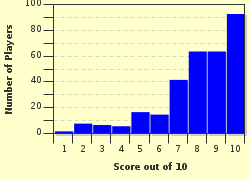Quiz Answer Key and Fun Facts
1. All cricketing positions are defined in reference to one person. Who is this critical participant in the game?
2. Only one fielding player wears gloves, as he crouches to field near the batsman. What is the name for his position?
3. Somebody has to get things going by delivering the ball which the batsman must keep from getting past him (if he misses and the bails are dislodged from the stumps on which they rest, he is out) and attempt to hit far enough away so he can score runs. Who is this pivotal member of the fielding team?
4. You often see a group of fielders standing in an arc near the wicket-keeper. Where are these players said to be standing?
5. One of the two field umpires usually stands on an imaginary line running through the stumps at the batsman's end of the pitch, facing the batsman's rump. Which of these fielders stands close to this umpire?
6. Since there are 11 fielders, the position known as third man is somewhat puzzling for the neophyte. Where on the field does this player stand?
7. As I am standing at my normal position of mid-wicket, I see the captain waving his arms to tell me that I have to move further out towards the boundary. To what position has he moved me?
8. I just got moved from point to backward point. How did my position change?
9. As I saw the wicket-keeper fetching a fielding helmet from its hidey-hole, I just knew the news was going to be bad. In which of the following positions would I expect to need to wear a fielding helmet?
10. Although it is not an official name for a fielding position, there is one term that commentators love to use for the position on the boundary between deep mid-wicket and long on. What is the agricultural nickname for this position?
Source: Author
looney_tunes
This quiz was reviewed by FunTrivia editor
Dalgleish before going online.
Any errors found in FunTrivia content are routinely corrected through our feedback system.

